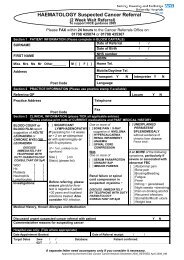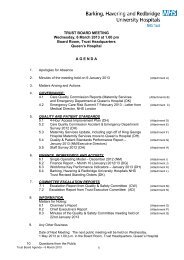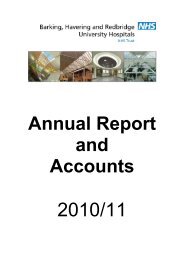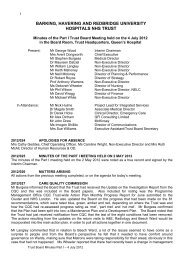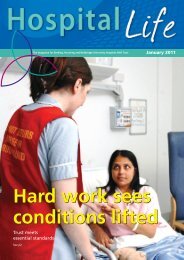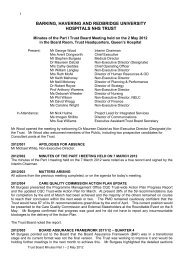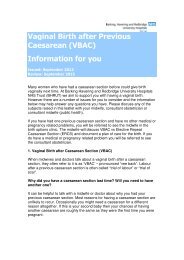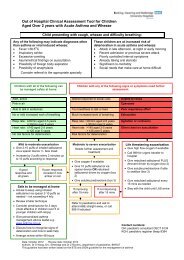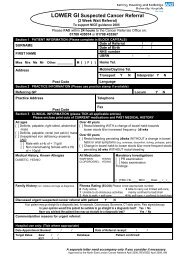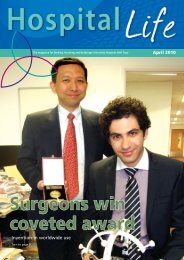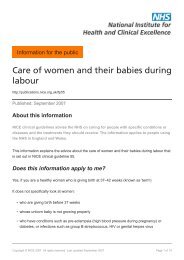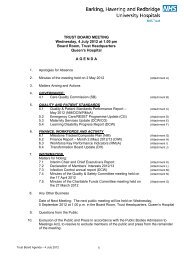Trust Board papers November 2012 - Barking Havering and ...
Trust Board papers November 2012 - Barking Havering and ...
Trust Board papers November 2012 - Barking Havering and ...
You also want an ePaper? Increase the reach of your titles
YUMPU automatically turns print PDFs into web optimized ePapers that Google loves.
4.8 RISK REGISTER<br />
The Risk Registers set out the existing controls that relate to the risk as most are already subject<br />
to some degree of management. This helps BHRUT to set a more realistic or “real” prioritisation<br />
of the issues by assignment of a residual risk score. This means effort <strong>and</strong> resource can be<br />
targeted to mitigate or manage the risk <strong>and</strong> actions with responsibilities <strong>and</strong> target dates being set<br />
out in the Risk Register. Through this reassessment of priority scores (using the “Residual Risk<br />
Score) further work or “solutions” can be planned to address the risk until it reaches an<br />
acceptable level (i.e. within the risk appetite set).<br />
Managing risk is part of everyday management in the NHS, however due to the time that is<br />
required to implement solutions to risks <strong>and</strong> financial constraints; the concept of Risk Registers<br />
has been developed to provide an on-going log of these risks. Risk Registers are primarily an<br />
internal management tool to support Directorates/corporate departments in managing their risks<br />
whilst there is an opportunity to raise/escalate particular risks for inclusion on to the <strong>Trust</strong>’s<br />
Corporate Risk Register <strong>and</strong> the <strong>Board</strong> Assurance framework for input on mitigation of the risk.<br />
It is the policy of the <strong>Trust</strong> to maintain a Risk Register recording financial <strong>and</strong> non-financial risks<br />
as identified by its processes for continuous risk identification <strong>and</strong> risk assessment. For the<br />
avoidance of doubt, non-financial risks include clinical, non-clinical <strong>and</strong> organisational risks.<br />
The Risk Register is maintained <strong>and</strong> updated by the Risk Management Team <strong>and</strong> provides<br />
quarterly reports to the directorates via the Safeguard Risk Management system to enable them<br />
to scrutinise their risk to ensure that they are adequately described <strong>and</strong> graded <strong>and</strong> that action<br />
plans are formulated the Risk register.<br />
4.8.1 Clinical Directorate risk registers<br />
All risks must be submitted with a risk assessment <strong>and</strong> an action plan which would be updated to<br />
reflect the current Directorate risk profile, Risk action plan with details of key dates <strong>and</strong><br />
individual responsibility for action should be integrated into service plans <strong>and</strong> project<br />
plans. Appropriate review is needed to keep the risk register current. Each risk owner will<br />
need to have a securely retained copy of the register <strong>and</strong> a clear<br />
history of changes made as risk registers may be requested at any time by<br />
decision makers, project boards, the Risk Manager, Internal or External Auditors<br />
or any interested parties in the interest of openness & accountability<br />
Local Monitoring of incidents, complaints <strong>and</strong> claims including serious incidents<br />
Make reference to policies<br />
4.9 BOARD ASSURANCE FRAMEWORK<br />
The <strong>Board</strong> Assurance Framework (BAF) will identify which of BHRUT’s principal objectives are at<br />
risk because of inadequacies in the operation of the organisational controls or areas where the<br />
organisation has insufficient assurance about the effectiveness of the controls in place. At the<br />
same time the <strong>Board</strong> Assurance Framework will provide structured assurances where key risks<br />
are being managed effectively <strong>and</strong> which principal objectives are being delivered.<br />
The <strong>Board</strong> Assurance Framework will form the key document for the <strong>Trust</strong> <strong>Board</strong> in ensuring all<br />
principal risks are controlled, that the effectiveness of these key controls has been assured, <strong>and</strong><br />
that there is sufficient evidence to support the Annual Governance Statement<br />
Review by the <strong>Trust</strong> <strong>Board</strong> of the BAF provides the opportunity for risk to prioritisation <strong>and</strong> ensure<br />
effective performance management. The structure of the BAF allows for the identification of where<br />
the <strong>Trust</strong>’s objectives may not be met because of inadequacies in the operation of controls or<br />
where the organisation has insufficient assurances.<br />
<strong>Barking</strong>, <strong>Havering</strong> & Redbridge University Hospitals NHS <strong>Trust</strong> Page 20 of 40<br />
????????????? ??/??/???? Version ?? Issued ????



![[4] Biopsy Leaflet.pub - Barking, Havering and Redbridge University ...](https://img.yumpu.com/51285530/1/190x134/4-biopsy-leafletpub-barking-havering-and-redbridge-university-.jpg?quality=85)

